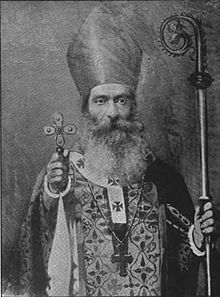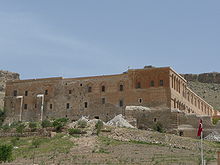- Ignatius Michael III Jarweh
-
Mar Ignatius Michael III Jarweh Patriarch of Antioch 
Church Syrian Catholic Church See Patriarch of Antioch Enthroned 22 January 1783 Reign ended 4 September 1800 Successor Ignatius Michael IV Daher Personal details Birth name Dionysius Michael Jarweh ibn Ni'matallah Born 3 January 1731
Aleppo, SyriaDied 4 September 1800
Al-Charfet monastery, Mount LebanonResidence Aleppo, and then Charfet Mar Ignatius Michael III Jarweh ibn Ni'matallah (or Javré, Jaroueh, Garweh, Djarweh, Giarvé, 1731–1800) was the 111 Patriarch of Antioch and Patriarch of the Syrian Catholic Church, from 1783 to 1800. In 1757 Michael Jarweh converted to Catholicism and took with him a large number of his congregants.[1]
Contents
Life
Bishop of Aleppo
Michael Jarweh was born on 3 January 1731 in Aleppo. He spent some time as deacon in Edessa and in 1757 he was ordained a priest by the Syrian bishop of Aleppo, George Fattal, who also appointed him as procurator of the church of Aleppo[2]:171. He distinguished for his sermons and for his concern for the poor.[3]
In those years Michael came in contact with the Melkite Archbishop Ignatius Karbousse of Aleppo. He also was on good terms with the Jesuit missionaries, who were respectful of the Oriental traditions, while he always had difficulties with the Franciscan missionaries, more inclined to ask for latinization. In November 1757 Michael made a pilgrimage to Jerusalem and from that time he was a Catholic at heart.
A few years later Michael Jarweh decided to visit the Syrian Patriarch Ignatius George III in Amid and to explain to him his belief in union with Rome. He did not succeed in persuading the Patriarch to enter into communion with the Catholic Church, but Michael impressed the Patriarch so much that he was appointed bishop of Aleppo, being consecrated in the Church of Our Lady in Amid on February 23, 1766 by the Patriarch himself.[2]:174
A short time after Michael Jarweh returned to Aleppo, the Patriarch died and the new Patriarch, Ignatius George IV, was strongly opposed to any relations with the Catholic Church. He summoned Michael to visit him with a letter dated January 5, 1769. Thus Michael reached the Patriarch's abode, the Dayr al-Zafaran monastery, where he tried to persuade the Patriarch about his faith, with the only result being his imprisonment for four years in the monastery. In 1772, while Michael was being forcibly kept in the monastery, the Patriarch denounced and made imprisoned other pro-Catholics in Aleppo.[2]:176 They were released by the Ottoman authorities only after the payment of a large ransom. Early in 1773, these believers met in the Church of Our Lady in Aleppo and wrote a letter to Rome asking for communion.
Michael Jarweh escaped from the Dayr al-Zafaran monastery only a year later, and on December 8, 1774 he reached his flock in Aleppo. On December 16, 1774 Michael made a profession of faith in front of the Melkite Archbishop Karbousse and wrote to Rome. Because of some contrary reports of both the Franciscan missionaries and of the Catholic delegate for the Syrians Joseph Kodsi, Rome took some time to take a decision in favor of Michael, but on June 23, 1775 Pope Pius VI recognized Michael as a true Catholic and as bishop of Aleppo.
In Aleppo, Michael continued to be the object of attacks from the traditionalists[3], who according to Ottoman Law also had civil authority over him, and he had to escape to Cyprus and later to Egypt. Having returned to Aleppo, he went on persuading, with success, bishops and believers about his idea of full communion with the Catholic Church.
Patriarch
On July 21, 1781, Patriarch George IV died, and the bishops (five bishops were present), clergy and laity met in the Dayr al-Zafaran monastery and elected him as Patriarch; he accepted only after the reading and the approval of a Catholic declaration of faith in the church of the Forty Martyrs. He was enthroned in Dayr al-Zafaran monastery on January 22, 1783 and took the traditional name of Ignatius III. His election was confirmed by the Pope on September 14, 1783, and he received the Pallium, the sign of patriarchal authority, on December 15 of the same year. The Syrian Catholic Church once again had a Patriarch, having lacked one since the death in 1702 of Ignatius Gregory Peter VI Shahbaddin.
Two bishops opposed his election: two days after Michael's enthronement they took the money of the monastery and paid a group of Kurds who attacked Mardin[4]:390 making fatalities: Michael saved himself, but lost many days. In the meantime one of these two Orthodox bishops, Mar Matta ben Abdel-Ahad Saalab bishop of Mosul, consecrated bishop four his monks[4]:391 in order to held a second election[1] and thus he was elected patriarch. This party arrived at Istanbul before Michael's envoy, and received the formal approval of the Ottoman authorities: thus Michael became an outlaw and was imprisoned. After the payment of a ransom, Michael moved to Baghdad, waiting for the appeal, and later escaped from Baghdad disguised as Bedouin[4]:396. He arrived in Lebanon having lost everything, and went to live in the ruins of the Kesroan monastery.
Helped by the Maronites, and with some funds raised in Europe, Michael Jarweh bought on September 22, 1786[5]:222 the Al-Charfet (or Sharfeh) monastery on Mount Lebanon that he dedicated to Our Lady of Deliverance. This monastery was used as a seminary for the education of new priests and a large library was set up. On September 19, 1791 the patriarchal See was moved from Mardin to Al-Charfet; it is still used as the summer abode of the Syrian Catholic Patriarch. Lebanon granted a certain security, but the majority of believers lived far away, mainly in the areas of Aleppo and Mosul.
Michael Jarweh died on September 4[6], 1800.
Works
Michael Jarweh left many homilies, a text on the sacrifice of the Mass, and an autobiography[4]
Notes
- ^ a b Frazee, Charles A. (2006). Catholics and Sultans: The Church and the Ottoman Empire 1453–1923. Cambridge University Press. pp. 207–209. ISBN 9780521027007. http://books.google.com/?id=X6DM4szwUpEC&printsec=frontcover#PPA208,M1. Retrieved 2009-02-22.
- ^ a b c Chalfoun, Pierre (1986). "L'Eglise Syrienne Catholique en Syrie au XVIIIéme siecle". Parole de l'Orient 13: 165–182.
- ^ a b Aubert R. (1997). "1. Jarweh". Dictionnaire d'histoire et de géographie ecclésiastiques. 26. Paris: Letouzey et Ané. pp. 1082–83. ISBN 270630202X.
- ^ a b c d Michael Jarweh autobiography: French translation in: Revue de l'Orient chrétien, VI (1901), pag 379-401
- ^ Chalfoun, Pierre (1979-80). "L'Eglise Syrienne Catholique et le Patriarche Michel Giavré sous le governement ottoman au XVIIIème siècle". Parole de l'Orient 9: 205–238.
- ^ or September 14 according to the Gregorian Calendar adopted in 1836 by the Syriac Catholic Church
Categories:- Converts to Catholicism from Oriental Orthodoxy
- Converts to Eastern Catholicism
- Syriac people
- Syriac Catholic Patriarchs of Antioch
- 1800 deaths
- 1731 births
- Syrian bishops
- People from Aleppo
Wikimedia Foundation. 2010.

